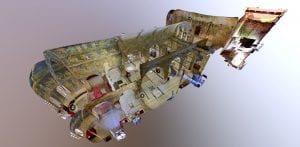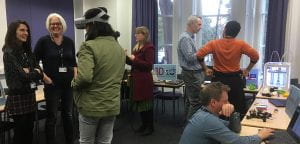Image: Interior St. Sophia church photogrammetry scan by Miguel Bandera. CC Attribution-NonCommercial-ShareAlike
Tying nicely with Catherine’s ‘Digital Toast’ post of last month. I’d like to share a case study explaining why the Research Support team is currently exploring the third dimension and how the work will help shape the new university library. The case study has been prepared for RLUK’s Digital Scholarship Network.
Overview
In summer 2018 plans for a new central university Library here at Bristol, reached an important milestone; the initiation of Royal Institute of British Architects (RIBA) Stage 2: Concept Design. This stage calls for more clarity about what’s to be built. By this point, many of the functions of our new library were clearly defined and understood. Plans for study spaces, for example, were already defined in terms of scale. We also had a good idea of what the nature of these study spaces would be.
One area which was not so clearly defined was the library-as-laboratory. This concept relates particularly to, but is not limited to, arts and humanities research. The idea that the Library could usefully serve as a hands-on space for ‘making’ research, had been in place since the new library’s initial conception.
There are several factors which led to this decision; Bristol’s expanding academic interest in digital humanities, the founding of a dedicated Research Support team with the library, the growing importance of working with partners within the creative industries.
By the beginning of RIBA Stage 2 we knew we wanted a ‘maker space’, and also that the library-as-laboratory concept could extend further than this, into the University’s plans for creating a new cultural collections space.
Identifying the need
In 2018 the Research Support team led a requirements gathering exercise, clarifying the practical requirements for the library-as-laboratory idea. Several different areas emerged as being of interest to our researchers and research students; for example, network analysis and text mining. However, this case study will focus on one particular area of unexpected interest, one which has implications for us as we build our new library; the creation, use and sharing of digital 3D information.
Among the most popular topics was the digitisation of 3D objects and so the Research Support Team implemented new training and since 2017 we’ve offered regular hands-on workshops in both 2D and 3D digitisation and attendance has always been strong.
With the aim of gathering more data, in early 2018 we began a series of drop-in sessions around campus. These took the 2017 survey as a starting point and allowed us to actually demonstrated many of the technologies which appeared to be of interest to our researchers.
The 3D tool sand technologies we demonstrated were;
- Structured light 3D scanners
- Digital 3D models produced via photogrammetry
- 3D prints and a 3D printer
- A 360 degree, stereoscopic video camera, the Insta360 Pro. 360 degree video had been linked to VR in the 2017 survey
- VR headsets showing both 360 videos and digital 3D games with a research focus
- A holographic monitor (the Looking Glass by the Looking Glass Factory)
Image: Drop-in technology session, Faculty of Arts
These events were aimed at both academic staff and research students although precisely who was invited was left to administrative staff at school level. We also put up posters advertising each event, and anyone was welcome to attend.
The results included some surprises including;
- A truly cross-discipline interest from within the Arts and Social Sciences faculties
- An interest in 3D motion capture (of human movement), principally from Drama. We’d not considered this before
- Questions over digital 3D content as part of the standard library stock were raised. E.g. library access to VR games or 360 video programmes
The information we’ve gathered so far has been reinforced with several useful visits to other research organisations; most notably Edinburgh University and Exeter Digital Humanities Lab.
Outcomes
Despite their broad research aims, we’ve been able to define a set of digital 3D activities which are of interest to our researchers. They are:
- Topographical 3D scanning of tabletop-scale objects
- Topographical 3D scanning of larger than tabletop-scale objects, this to include truly portable equipment for architectural and archaeological field work
- Capture of 3D human motion
- Building digital 3D models from scratch or enhancing 3D scans or motion capture data using computer graphics applications
- Taking 3D assets and adding interactivity, ideally achieved using an off-the-shelf game engine
- Packaging 3D scans for delivery via a specific hardware or software platform
- Delivery of 3D data, including but not limited to; in-browser, VR headset, AR headset, CAVE (Cave Automatic Virtual Environment) projections and 3D prints
- Not truly 3D, but there is also a clear interest in stereoscopic, 360 degree immersive video, especially when coupled with VR as a delivery mechanism
Our aim is to build a facility which will support these. The new types of spaces we believe are needed are adaptable, have controllable lighting and be as large as as we can make them. Areas with benches will support table-top work while open plan areas will be used for large-scale 3D scanning, VR and motion capture. These spaces will be located predominantly within the maker space but other parts of the library will also play a part. For example, the new Cultural Collections area will have it’s own 3D scanning area and a new exhibition space will support group VR.
We’re not yet at the stage of producing a detailed breakdown of running costs but we acknowledge the need for ongoing investment in staff equipment, as the technologies we’ve chosen to support evolve rapidly and become out of date quickly.
The range of research activities we’ve identified which involve the creation, use or dissemination of 3D content has been immense; from digital anastylosis within Archaeology to 3D printing life-sized Czechoslovakian landmines in History.
Identifying exactly how 3D tools and techniques will be used within research has proven not only impossible but counterproductive since we actively encourage innovative uses. Fortunately, we have found that we’ve been able to make progress without prescribing how we expect our new facilities to be used.
Lessons learned so far
- Our expectation that disciplines such as Archaeology would have a high degree of interest in digital 3D while disciplines such as Philosophy would not, has proved largely unfounded
- Investing in this area has benefited our in-house cultural collections. 3D scanning has offered us an important way to maximize the potential of artifacts, costumes and physical models
- As the research support team, research has been our focus, but most of what we’ve established and achieved is relevant to teaching and learning uses of digital 3D
- Much of the work we’ve been doing has been reactive but there is a proactive element. We hope that if we build inspiring research spaces, inspiring research will follow


